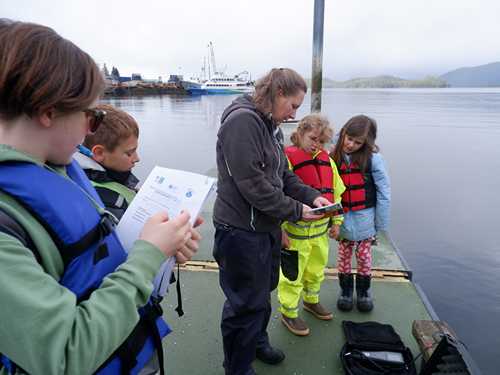Our Terms & Conditions | Our Privacy Policy
4-H pH program gives Sitka youth a taste of ocean science
Photo by Jasmine Shaw
Children participating in the 4-H pH program check ocean water measurements from a Sitka, Alaska, dock while instructor Nicole Filipik explains a chart.
Youth in Sitka spent five months testing the water as part of an ocean acidification education program called 4-H pH.
4-H pH is led by personnel from three units at the University of Alaska Fairbanks: 4-H program assistant Jasmine Shaw with the Cooperative Extension Service, Christina Buffington with the Geophysical Institute and Natalie Monacci with the College of Fisheries and Ocean Sciences.
The project, funded by the NOAA Ocean Acidification Program, is part of a citizen science program called Global Learning & Observations to Benefit the Environment Program, or GLOBE. The program is led by NASA to advance science and educate tomorrow’s workforce. The National Science Foundation, National Oceanic and Atmospheric Administration and U.S. Department of State are also part of GLOBE.
The idea was to create a curriculum designed for elementary school-age students that anyone could use, not just 4-H, to teach about ocean acidification, Shaw said.
“Everything you find online is more middle school and high school geared,” she said. “The purpose was to be able to teach it to a younger group of folks through place-based approaches that are relevant to a community.”
About a dozen students participated in the program from January to May 2025. They learned to measure pH, temperature and dissolved oxygen, and the measurements were uploaded to the GLOBE program’s open-source database. During spring break, 4-H pH assisted the Sheet’ká Ḵwáan Tribe on its weekly ocean-monitoring trip and learned about pH in the kitchen with a guest chef. They also created artworks as part of the program and looked at future career opportunities.
“We met with scientists at the tribe who measure ocean acidification here in Sitka, so that the kids could see it as a career pathway,” Shaw said. “Also, they could see what we’re measuring is the same thing as what these adults are measuring, and why it matters.”
This summer, Shaw is taking the curriculum she developed to 4-H camps in Angoon and Petersburg.
“In some of these communities in Southeast, they are monitoring ocean acidification, and in some they might not be. So the idea is also for community awareness,” Shaw said.
Images are for reference only.Images and contents gathered automatic from google or 3rd party sources.All rights on the images and contents are with their legal original owners.



Comments are closed.